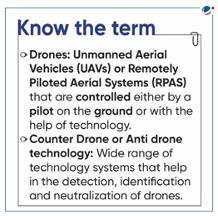Why in the news?
Adani Defence and Aerospace recently introduced the Drishti 10 Starliner Unmanned Aerial Vehicle (UAV) for the Indian Navy.
More on the News
- The UAV embarked on its journey from Hyderabad to Porbandar, marking its induction into naval maritime operations.
- It is Indian Navy’s first indigenously manufactured UAV, with over 60% indigenous content.
- It would promote the navy’s Maritime Domain Awareness (MDA) and augment their anti-piracy and seaborne missions.
- Key features:
- Advanced intelligence, surveillance, and reconnaissance (ISR) Platform
- Medium Altitude Long Endurance (MALE) UAV
- 450 kg payload capacity
- Received STANAG 4671 certification (NATO standardization agreement)
- The step highlights the significance of drone technology for security purposes.

Role of Drones in National Security
- Surveillance and Intelligence: Drones can be used in remote surveillance, reconnaissance and intelligence-gathering operations by security agencies.
- Offensive military operations: Drones can be used to strike the enemy or its infrastructure in deep, inhospitable locations.
- Replacing manned aircrafts: It helps in achieving military goals without the risk posed to pilots’ life during security operations.
- Military logistics: Indian army has planned to replace mules and choppers with drones for supplies at forward posts along the Line of Actual Control (LAC) in Ladakh, Leh, and Northeastern India.
- Serve as force multiplier: AI enabled drones are capable with communicating with each other, Automatic Target Recognition (ATR) and coordinating with ground based conventional military operations.
- Use for maintaining law and order: Police drones can be used to monitor large crowds, surveillance of illegal activities, search and rescue operations etc.
Concerns associated with Drone technology
- Threat to national security: Drones falling in hands of rouge elements can pose a threat to national security.
- E.g., Cross border infiltration of drones along the international border with Pakistan for dropping improvised explosives, weapons and drugs.
- Rogue drones also pose a threat to civilian aerospace and critical infrastructure, like, Nuclear Installations.
- Shortage of skills in Drone ecosystem: There is overall shortage of skilled drone operators, drone engineers, service engineers, quality inspectors etc.
- Global positioning system (GPS) denied environments: Imported drones using GPS navigation devices may find operational issues in GPS-denied environments.
- E.g., Heron Mk II MALE UAV purchased from Israel.
- Shortage of drone batteries: Due to weight concerns, advanced Lithium-ion battery technologies are now being used for drone development instead of traditional Nickel- Cadmium and Silver-Zinc batteries.
- DRDO and ISRO are working on Lithium-Ion cell development, but the activity is still in infant stage.
- Ethical and Moral Concerns: Since the usage of long-range drone attacks by American -forces, they have been criticized for their disproportionate impact on civilian communities.
Drone regulations in India
|
India’s Initiatives for use of Drone Technology in defense sector
- Acquisition of foreign drones: India has imported drone technology from various countries like the US and Israel.
- Heron Mark-II drones: A Medium Altitude Long Endurance (MALE) UAV, inducted by Indian Air Force to carry out surveillance along Northern borders with Pakistan and China.
- Searcher Mk II drones: Developed by Israel Aerospace Industries, it is a reconnaissance drone used by Indian army and navy.
- Drone, Detect, Deter and Destroy (D4 System): DRDO developed indigenous anti-drone system, inducted into the Indian Armed Forces.
- Border Security: BSF has deployed hand-held static and vehicle-mounted anti-drone systems to counter rising drone threat along Indo-Pak Border.
- Indigenous UAV systems: DRDO has been developing UAV systems which are at varying stages of development.
Indigenous drones of DRDO | |
DRDO Lakshya
|
|
DRDO Nishant |
|
RUSTOM-1 |
|
TAPAS/ Rustom-2 |
|
Archer
|
|
Way forward
- Research and Development: To facilitate faster development and deployment of indigenous UAV and counter UAV technology.
- Involvement of private sector: To upgrade private sector’s capability to manufacture key components used in drones in order to substitute their imports.
- Further, defence startups must be encouraged to develop military grade drones under initiatives like Innovations for Defence Excellence (iDEX) initiative.
- Tri services joint doctrinal framework on drone deployment: This would bring synergy in drone operations and address ethical issues by fixing accountability framework for military usage of drones.



